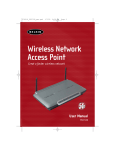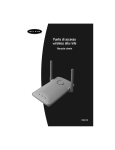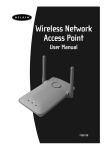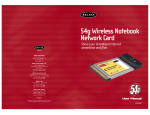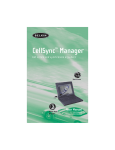Download Belkin F5D6130 User manual
Transcript
P74341_F5D6130_v2K_man.qxd 9/16/03 10:05 AM Page 2 Wireless Network Access Point User Manual F5D6130 P74341_F5D6130_v2K_man.qxd 9/16/03 10:05 AM Page 3 TABLE OF CONTENTS Introduction . . . . . . . . . . . . . . . . . . . . . . . . . . . . . . . . . . . . . . . . . . 1 Key Features . . . . . . . . . . . . . . . . . . . . . . . . . . . . . . . . . . . . . . .2 Package Contents . . . . . . . . . . . . . . . . . . . . . . . . . . . . . . . . . . . .3 Optional Management . . . . . . . . . . . . . . . . . . . . . . . . . . . . . . . . .3 Software Requirements . . . . . . . . . . . . . . . . . . . . . . . . . . . . . . . . .3 System Requirements . . . . . . . . . . . . . . . . . . . . . . . . . . . . . . . . . .3 Specifications . . . . . . . . . . . . . . . . . . . . . . . . . . . . . . . . . . . . . .4 Knowing your Access Point . . . . . . . . . . . . . . . . . . . . . . . . . . . . . . . . .5 Placement of your Access Point . . . . . . . . . . . . . . . . . . . . . . . . . . . . . .7 Quick Setup . . . . . . . . . . . . . . . . . . . . . . . . . . . . . . . . . . . . . . . . . . .8 Step 1: Connect the AP to a Router, Ethernet Switch, or Hub . . . . . . . .8 Step 2: Install the Discovery Wizard . . . . . . . . . . . . . . . . . . . . . . . .9 Using the Discovery Wizard to Configure the AP . . . . . . . . . . . . . . . . . .11 Configuring the Wireless Network Settings . . . . . . . . . . . . . . . . . . . . . .15 Troubleshooting . . . . . . . . . . . . . . . . . . . . . . . . . . . . . . . . . . . . . . .29 Information . . . . . . . . . . . . . . . . . . . . . . . . . . . . . . . . . . . . . . . . . .30 P74341_F5D6130_v2K_man.qxd 9/16/03 10:05 AM Page 1 INTRODUCTION Thank you for purchasing the Belkin Wireless Network Access Point (AP) and welcome to the world of wireless networking. Now you can take advantage of this great new high-speed wireless technology and gain the freedom you need around the home or office—without using cables. The AP acts as a bridge between your existing wired network and your wireless-equipped computers. The easy installation and setup will have you networking wirelessly in minutes. Please be sure to read through this manual completely to be sure that you are getting the most out of your AP. 1 P74341_F5D6130_v2K_man.qxd 9/16/03 10:05 AM Page 2 INTRODUCTION Key Features Wide Area Coverage at High Speeds The Belkin AP provides coverage over an indoor area up to 300 feet in radius, and outdoor area over 1,500 feet in radius. Up to 128-Bit Encryption Your Belkin AP is capable of encrypting (scrambling) the transmitted radio waves so you can be sure that your data is secure. The optional encryption feature allows you to encrypt at 64 bits or 128 bits using a key that you enter yourself. MAC Address Filtering For added security, you can set up a list of MAC addresses (unique client identifiers) that are allowed access to your network. Every computer has its own MAC address. Simply enter these MAC addresses into a list using the web-based user interface and you can control access to your network. Works with Both PCs and Mac® Computers The Access Point supports a variety of networking environments including Mac OS® 8.x, 9.x, X v10.x, AppleTalk®, Linux®, Windows® 95, 98, Me, NT®, 2000, and XP, and others. Note: The Access Point can be managed through a web browser without the included software. The software included supports Windows 98 SE, Me, 2000, and XP only but IS NOT necessary to use the Access Point. Web-Based Advanced User Interface You can set up the AP’s advanced functions easily through your web browser, without having to install additional software onto the computer. There are no disks to install or keep track of and, best of all, you can make changes and perform setup functions from any computer on the network quickly and easily. Applications and Advantages • Economically connect multiple wireless computers to a network • SOHO (Small Office/Home Office) networking needs • Provides the easy and quick small network installation SOHO users need. 2 P74341_F5D6130_v2K_man.qxd 9/16/03 10:05 AM Page 3 INTRODUCTION Package Contents • Belkin Wireless Network Access Point • Power Supply • Software CD • User Manual • Registration Card Optional Management Software Requirements • Windows® 98SE, Me, 2000, or XP • Minimum 64MB RAM System Requirements • At least one computer with TCP/IP networking protocol installed • CAT5 networking cable (or better) • Microsoft® Internet Explorer 4.0 or later, or Netscape® 4.0 or later 3 P74341_F5D6130_v2K_man.qxd 9/16/03 10:05 AM Page 4 INTRODUCTION Specifications Standards: IEEE 802.3 10Base-T Ethernet/100 Base-Tx Ethernet IEEE 802.11b Wireless: Radio Technology: Direct Sequence Spread Spectrum (DSSS) 802.11b: 11, 5.5, 2, 1Mbps 802.11b: CCK, DQPSK, DBPSK 2.412-2.497GHz ISM band 802.11b: 11 for North America, 14 for Japan, 13 for Europe 64/128-bit WEP Protocol Supported: CSMA/CD, TCP, IP, UDP, and DHCP (client) Management: Browser-Based Maximum Users: 32 (WLAN) Ports: 1 10Base-T/100Base-Tx RJ45 port 1 Power jack 1 Reset button LEDs: Power LAN Activity WLAN Activity 4 P74341_F5D6130_v2K_man.qxd 9/16/03 10:05 AM Page 5 KNOWING YOUR ACCESS POINT The AP has been designed to be placed on a desktop vertically or horizontally, or it may be mounted to a wall. The slim design minimizes the desktop space required when placed vertically. All of the cables exit from the rear of the AP for better organization and utility. The LED indicators are easily visible on the front of the AP to provide you with information about network activity and status. Front Panel Wireless LAN LED LAN (Network) LED Power/Ready LED Power/Ready LED Indicates that the AP is receiving power. Off AP is OFF Red AP is ready Wireless LAN LED Off Wireless network is OFF Blinking Green Indicates AP is working LAN (Network) LED Off No network is linked to the port Green 10Base-T device connected Orange 100Base-Tx device connected Blinking (Orange or Green) Port activity Rear Panel Power Jack RJ-45 LAN Port 5 P74341_F5D6130_v2K_man.qxd 9/16/03 10:05 AM Page 6 KNOWING YOUR ACCESS POINT Power Jack Connect the included 5V DC power supply to this jack. RJ45 Ethernet Jack Connect an Ethernet cable to this socket, and connect to an open RJ45 10Base-T or 100Base-T port on a switch, router, or hub. Reset Button The Reset button is used in rare cases when the AP may function improperly. Resetting the AP will restore the AP’s normal operation while maintaining the programmed settings. You can also restore the factory default settings by using the Reset button. Use the restore option in instances where you may have forgotten your custom password. a. Resetting the AP Push and release the Reset button. The lights on the AP will momentarily flash. The Power/Ready light will begin to blink. When the Power/Ready light becomes solid again, the reset is complete. b. Restoring the Factory Defaults Press and hold the Reset button for five seconds then release it. The lights on the AP will momentarily flash. The Power/Ready light will begin to blink. When the Power/Ready light becomes solid again, the restore is complete. Rotatable Dipole Antenna One unidirectional dipole antennas is located on the side of the AP. The antennas can rotate 180 degrees. The antenna should be oriented in the vertical position for best performance. 6 P74341_F5D6130_v2K_man.qxd 9/16/03 10:05 AM Page 7 PLACEMENT OF YOUR ACCESS POINT Proper placement of your AP is important to ensure the best performance of your wireless network. Indoors, your Wireless Access Point can typically provide a circular coverage area of 300 feet or more. However, different types of construction materials and other obstructions in a building can greatly affect the wireless signal and decrease the range. If possible, place your AP as close as possible to the center of the area that you want to cover. In multistory homes, place the AP on a floor that is as close to the center of the home as possible; this may mean placing the AP on an upper floor. Use care when choosing the location of your AP • Be aware of appliances or large objects such as a refrigerator or washer/dryer unit that may be on the opposite side of a wall from where you decide to place your AP. • Place the AP on top of a desk and away from metal cabinets and computer cases. • Do not place objects or components on top of the AP. • Make sure that the antenna is pointing UP at all times. • Metallic-based UV window tint can affect wireless performance. Do not place the AP next to a tinted window. We realize that in the real world, it may not be possible to place your AP in the center of your coverage area. In cases where you may experience difficulty covering the entire area you want, try placing the AP as high as possible. Wireless devices work best in a line-of-sight situation where there are no obstacles between the wireless computer and the AP. The AP may also be mounted to a wall with the antennas facing UP. There are other options for expanding your wireless coverage area. Visit http://www.belkin.com/networking for solutions. The wireless signal can be affected by many things including neighboring wireless networks, microwave ovens in operation, and 2.4GHz cordless phones. While these things can affect the network performance, your wireless network typically will work fine under most conditions where these devices exist. 7 P74341_F5D6130_v2K_man.qxd 9/16/03 10:05 AM Page 8 QUICK SETUP The AP is configured at the factory to operate correctly out-of-the-box. Simply connecting the AP to your existing network will instantly add wireless capabilities to your network with no further configuration required. Belkin ships software that will allow you to locate and connect to the Access Point on your network so you can easily change or modify the settings if you wish. Before you can use the software, you must physically install the Access Point. Once the AP is installed, you can use the software to modify the settings. Follow the steps below to install your AP. Step 1: Connect the AP to a Router, Ethernet Switch, or Hub Verify the contents of your box. You should have the following: • Belkin Wireless Network Access Point • Power Supply • Software CD • User Manual • Registration Card 1. Select a suitable place for your AP as described in the previous section of this manual. 2. Connect a CAT5 cable between the AP and your router’s LAN port, Ethernet switch, or hub. Connect the power supply to the AP by plugging the round DC connector into the DC jack on the AP. Plug the power supply into the wall. Verify that the Power LED and the Link LED are illuminated. If both LEDs are illuminated, this indicates that the AP is connected properly. 3. Connection and placement of your AP is now complete. 8 P74341_F5D6130_v2K_man.qxd 9/16/03 10:05 AM Page 9 QUICK SETUP Step 2: Install the Discovery Wizard The Discovery Wizard is a convenient tool for locating and connecting to your AP. The Discovery Wizard is only necessary if you want to make changes to the AP’s settings, otherwise, the AP will work out-of-the-box in most cases. Since the AP is shipped from the factory as a DHCP client, it will obtain an IP address automatically from the DHCP server on your network. Since this address is somewhat random, the Discovery Wizard will locate the AP on the network for you so you don’t have to take extra steps to determine the IP address of the AP. 1. Insert the CD into your CD-ROM drive. 2. The Belkin Wireless Network Access Point Setup Utility screen will automatically appear. If it does not appear within 15-20 seconds, then select your CD-ROM drive and double-click on the folder named “Files”. Next double-click on the icon named “start.exe”. 3. In the menu window, drag your mouse over the “Install” button then select “Click here” to start the software installation program. 9 P74341_F5D6130_v2K_man.qxd 9/16/03 10:05 AM Page 10 QUICK SETUP 4. The software installation Wizard will start. Click “Next” on the first screen. 5. Accept the user agreement and click “Next” while following the installation Wizard through its steps. Click “Finish” on the last screen. 6. The Discovery Wizard is now installed. Go to the next section to learn how to use the Wizard. 10 P74341_F5D6130_v2K_man.qxd 9/16/03 10:05 AM Page 11 USING THE DISCOVERY WIZARD TO CONFIGURE THE AP 1. After you have installed the Discovery Wizard, you will see an icon on the desktop. Double-click the icon to start the Wizard. 2. When you start the Wizard, you will see the word “Scanning…”. This means the Wizard is looking for Access Points on your network. 3. When the Wizard finds your Access Point(s), the Access Point’s name will appear in this window. Click on the Access Point’s name. 4. Click “Connect”. This will launch your web browser. 11 P74341_F5D6130_v2K_man.qxd 9/16/03 10:05 AM Page 12 USING THE DISCOVERY WIZARD TO CONFIGURE THE AP 5. You will see the AP’s login page in your browser window. The AP ships with no password entered. In the login screen, leave the password blank and click the “Submit” button to log in. 6. You are now connected to the AP and can make any changes you want to. See the following section of this manual to learn how to use the interface. Logging Out of the AP One computer at a time can log into the AP for the purposes of making changes to the settings of the AP. Once a user has logged in to make changes, there are two ways that the computer can be logged out. Clicking the “Logout” button will log the computer out. The second method is automatic. The login will time out after a specified period of time. The default login time out is 10 minutes. This can be changed from 1 to 99 minutes. For more information, see the section in this manual titled “Changing the Login Timeout Setting”. 12 P74341_F5D6130_v2K_man.qxd 9/16/03 10:05 AM Page 13 USING THE DISCOVERY WIZARD TO CONFIGURE THE AP Understanding the Access Point User Interface The home page is the first page you will see when you access the Advanced User Interface (UI). The home page shows you a quick view of the AP’s status and settings. All advanced setup pages can be reached from this page. (2) (3) (4) (5) (1) (6) (7) (1) Quick-Navigation Links You can go directly to any of the AP’s advanced UI pages by clicking directly on these links. The links are divided into logical categories and grouped by tabs to make finding a particular setting easier to find. Clicking on the purple header of each tab will show you a short description of the tab’s function. (2) Home Button The home button is available in every page of the UI. Pressing this button will take you back to the home page. (3) Help Button The “Help” button gives you access to the AP’s help pages. Help is also available on many pages by clicking “more info” next to certain sections of each page. 13 P74341_F5D6130_v2K_man.qxd 9/16/03 10:05 AM Page 14 USING THE DISCOVERY WIZARD TO CONFIGURE THE AP (4) Login/Logout Button This button enables you to log in and out of the AP with the press of one button. When you are logged into the AP, this button will change to read “Logout”. Logging into the AP will take you to a separate login page where you will need to enter a password. When you are logged in to the AP, you can make changes to the settings. When you are finished making changes, you can log out of the AP by clicking the “Logout” button. For more information about logging into the AP, see the section called “Logging into the AP”. (5) Version Info Shows the firmware version, boot-code version, hardware version, and serial number of the AP. (6) LAN Settings Shows you the settings of the Local Area Network (LAN) side of the AP. Changes can be made to the settings by clicking on any one of the links (IP Address, Subnet Mask) or by clicking the “LAN” Quick Navigation link on the left side of the screen. (7) Wireless Shows the status of the AP’s wireless setting. Changes can be made to the settings by clicking on any one of the links or by clicking the “Quick Navigation” links on the left side of the screen. 14 P74341_F5D6130_v2K_man.qxd 9/16/03 10:05 AM Page 15 CONFIGURING THE WIRELESS NETWORK SETTINGS The Wireless tab lets you make changes to the wireless network settings. From this tab you can make changes to the wireless network name (SSID), operating channel, and encryption security settings. IP Settings 15 P74341_F5D6130_v2K_man.qxd 9/16/03 10:05 AM Page 16 CONFIGURING THE WIRELESS NETWORK SETTINGS Changing the Wireless Channel Auto: There are a number of operating channels you can choose from. In the United States, there are 11 channels. In the United Kingdom and most of Europe, there are 13 channels. In a small number of other countries, there are other channel requirements. Your AP is configured to operate on the proper channels for the country you reside in. The default channel is 11 (unless you are in a country that does not allow channel 11). The channel can be changed if needed. If there are other wireless networks operating in your area, your network should be set to operate on a channel that is different than the other wireless networks. For best performance, use a channel that is at least five channels away from the other wireless network. For instance, if another network is operating on channel 11, then set your network to channel 6 or below. To change the channel, select the channel from the drop-down list. Click “Apply Changes”. The change is immediate. 16 P74341_F5D6130_v2K_man.qxd 9/16/03 10:05 AM Page 17 CONFIGURING THE WIRELESS NETWORK SETTINGS Changing the Wireless Network Name (SSID) To identify your wireless network, a name called the SSID (Service Set Identifier) is used. The default SSID of the AP is “WLAN”. You can change this to anything you want to or you can leave it unchanged. If there are other wireless networks operating in your area, you will want to make sure that your SSID is unique (does not match that of another wireless network in the area). To change the SSID, type in the SSID that you want to use in the SSID field (1) and click “Apply Changes” (2). The change is immediate. If you make a change to the SSID, your wireless-equipped computers may also need to be reconfigured to connect to your new network name. Refer to the documentation of your wireless network adapter for information on making this change. (1) (2) Using the Broadcast SSID Feature Note: This advanced feature should be employed by advanced users only. For security, you can choose not to broadcast your network’s SSID. Doing so will keep your network name hidden from computers that are scanning for the presence of wireless networks. To turn off the broadcast of the SSID, remove the check mark from the box next to “Broadcast SSID”, and then click “Apply Changes”. The change is immediate. Each computer now needs to be set to connect to your specific SSID; an SSID of “ANY” will no longer be accepted. Refer to the documentation of your wireless network adapter for information on making this change. Changing the Wireless Security Settings Your AP is equipped with the security standard called WEP (Wired Equivalent Privacy). By default, wireless security is disabled. To enable security, follow the steps in this section. 17 P74341_F5D6130_v2K_man.qxd 9/16/03 10:05 AM Page 18 CONFIGURING THE WIRELESS NETWORK SETTINGS Setting WEP Encryption using a Passphrase Note to Mac users: The Passphrase option will not operate with Apple® AirPort®. To configure encryption for your Mac computer, set the encryption using the manual method described in the next section. 1. Select “128-bit automatically” or “64-bit automatically” from the drop-down menu. 2. Type in a passphrase. A passphrase is like a password. It can be a mixture of numbers and letters. After you type in your passphrase, click “Generate”. When you click “Generate”, the key fields below will become populated. Note: 64-bit encryption will generate four keys and 128-bit encryption will generate only one key. Select the key you want to use by clicking the radio button next to it. Click “Apply Changes”. 3. Encryption in the AP is now set. Each of your computers on your wireless network will now need to be configured with the same passphrase. Refer to the documentation of your wireless network adapter for information on making this change. 18 P74341_F5D6130_v2K_man.qxd 9/16/03 10:05 AM Page 19 CONFIGURING THE WIRELESS NETWORK SETTINGS Setting Encryption Manually Using a Hexadecimal Key A hexadecimal key is a mixture of numbers and letters from A–F and 0–9. 64-bit keys are five 2-digit numbers. 128-bit keys are 13 2-digit numbers. For instance: AF 0F 4B C3 D4 = 64-bit key C3 03 0F AF 0F 4B B2 C3 D4 4B C3 D4 E7 = 128-bit key In the boxes below, make up your key by writing in two characters between A–F and 0–9. You will use this key to program the encryption settings on your AP and your wireless computers. Note to Mac users: Original Apple AirPort products support 64-bit encryption only. Apple AirPort 2 products can support 64-bit or 128-bit encryption. Please check your product to see which version you are using. If you cannot configure your network with 128-bit encryption, try 64-bit encryption. 1. Select “64-bit manually” or “128-bit manually” from the drop-down menu. 19 P74341_F5D6130_v2K_man.qxd 9/16/03 10:05 AM Page 20 CONFIGURING THE WIRELESS NETWORK SETTINGS 2. If using 64-bit encryption, there will be four key fields. If using 128-bit encryption, there will be one key field. In the key field(s), type in the hexadecimal key(s) that you wish to use. When finished typing in your keys, select which key you want to use by clicking the radio button next to it. Click “Apply Changes”. 3. Encryption in the AP is now set. Each of your computers on your wireless network will now need to be configured with the same hexadecimal key. Refer to the documentation of your wireless network adapter for information on making this change. Setting MAC Address Filtering The MAC address filter is a powerful security feature that allows you to specify which computers are allowed access to the Access Point. Any computer NOT in the list will be denied access to the network. To Enable the MAC Address Filter 1. Place a check mark in the “Enable MAC Address Filtering” box (1). 2. Enter the MAC addresses of a computer that you want to allow access to the network. 3. Click “Add” (2) to add the address to the list. 4. Repeat for each computer you want to add to the list. 5. Click “Apply Changes” to finish. (1) (2) 20 P74341_F5D6130_v2K_man.qxd 9/16/03 10:05 AM Page 21 CONFIGURING THE WIRELESS NETWORK SETTINGS Client List You can view a list of clients that are currently associated with the AP using the Client List feature. You will be presented with the MAC address of the client and the speed at which it is connected. Advanced Settings Belkin provides a number of advanced functions that you can set. With exception to the AP name, it is recommended that you make no changes to these settings unless you have a specific reason to do so. From the Advanced Settings page you can do the following: • Change the AP name (used to uniquely identify the AP on your network) • Select the Basic Rate Set (1, 2Mbps or 1, 2, 5.5, 11Mbps) • Select the Transmit rate (Auto, 11Mbps, 5.5Mbps, 2Mbps, 1Mbps) • Set the RTS threshold • Set the Fragmentation threshold • Select the Preamble Type (Long or Short) When making changes, be sure to click “Apply Changes” for the changes to take effect. Utilities The Utilities screen lets you manage different parameters of the AP and perform certain administrative functions. Restarting the AP Sometimes it may be necessary to restart or reboot the AP if it begins working improperly. Restarting or rebooting the AP will NOT delete any of your configuration settings. 21 P74341_F5D6130_v2K_man.qxd 9/16/03 10:05 AM Page 22 CONFIGURING THE WIRELESS NETWORK SETTINGS Restarting the AP to Restore Normal Operation 1. Click the “Restart AP” button. 2. The following message will appear. Click “OK”. 3. The following message will appear. Restarting the AP can take up to 60 seconds. It is important not to turn off the power to the AP during the restart. 4. A 30-second countdown will appear on the screen. When the countdown reaches zero, the AP will be restarted. The AP home page should appear automatically. If not, type in the AP’s address (default = 192.168.2.254) into the navigation bar of your browser. Restoring Factory Default Settings Using this option will restore all of the settings in the AP to the factory (default) settings. It is recommended that you back up your settings before you restore all of the defaults. 22 P74341_F5D6130_v2K_man.qxd 9/16/03 10:05 AM Page 23 CONFIGURING THE WIRELESS NETWORK SETTINGS 1. Click the “Restore Defaults” button. 2. The following message will appear. Click “OK”. 3. The following message will appear. Restoring the defaults includes restarting the AP. It can take up to 60 seconds. It is important not to turn the power to the AP off during the restart. 4. A 30-second countdown will appear on the screen. When the countdown reaches zero, the AP’s defaults will be restored. The AP home page should appear automatically. If it does not, type in the AP’s address (default = 192.168.2.1) into the navigation bar of your browser. Saving a Current Configuration You can save your current configuration by using this feature. Saving your configuration will allow you to restore it later if your settings are lost or changed. It is recommended that you back up your current configuration before performing a firmware update. 23 P74341_F5D6130_v2K_man.qxd 9/16/03 10:05 AM Page 24 CONFIGURING THE WIRELESS NETWORK SETTINGS 1. Click “Save”. A window called “File Download” will open. Click “Save”. 2. A window will open that allows you to select the location where you want to save the configuration file. Select a location. You can name the file anything you want, or use the default name “Config”. Be sure to name the file so you can locate it yourself later. When you have selected the location and name of the file, click “Save”. The configuration is now saved. 24 P74341_F5D6130_v2K_man.qxd 9/16/03 10:05 AM Page 25 CONFIGURING THE WIRELESS NETWORK SETTINGS 3. When the save is complete, you will see the window below. Click “Close”. Restoring a Previous Configuration This option will allow you to restore a previously saved configuration. 1. Click “Browse”. A window will open that allows you to select the location of the configuration file. All configuration files end with a “.bin”. Locate the configuration file you want to restore and double-click on it. 25 P74341_F5D6130_v2K_man.qxd 9/16/03 10:05 AM Page 26 CONFIGURING THE WIRELESS NETWORK SETTINGS 2. You will be asked if you want to continue. Click “OK”. 3. A reminder window will appear. It will take up to 60 seconds for the configuration restoration to complete. Click “OK”. 4. A 60-second countdown will appear on the screen. When the countdown reaches zero, the AP’s configuration will be restored. The AP home page should appear automatically. If not, type in the AP’s address (default = 192.168.2.1) into the navigation bar of your browser. Updating Firmware From time to time, Belkin may release new versions of the AP’s firmware. Firmware updates contain feature improvements and fixes to problems that may have existed. When Belkin releases new firmware, you can download the firmware from the Belkin update website and update your AP’s firmware to the latest version. 26 P74341_F5D6130_v2K_man.qxd 9/16/03 10:05 AM Page 27 CONFIGURING THE WIRELESS NETWORK SETTINGS (1) Updating the AP’s Firmware 1. In the “Firmware Update” page, click “Browse” (1). A window will open that allows you to select the location of the firmware update file. All firmware files end with a “.dlf”. 2. Browse to the firmware file you downloaded. Select the file by doubleclicking on the file name. 27 P74341_F5D6130_v2K_man.qxd 9/16/03 10:05 AM Page 28 CONFIGURING THE WIRELESS NETWORK SETTINGS 3. The “Update Firmware” box will now display the location and name of the firmware file you just selected. Click “Update”. 4. You will be asked if you are sure you want to continue. Click “OK”. 5. You will see one more message. This message tells you that the AP may not respond for as long as one minute as the firmware is loaded into the AP and the AP is rebooted. Click “OK”. A 30-second countdown will appear on the screen. When the countdown reaches zero, the AP firmware update will be complete. The AP home page should appear automatically. Changing System Settings The “System Settings” page is where you can enter a new administrator password, set the time zone, enable remote management, and turn on and off the NAT function of the AP. 28 P74341_F5D6130_v2K_man.qxd 9/16/03 10:05 AM Page 29 CONFIGURING THE WIRELESS NETWORK SETTINGS Setting or Changing the Administrator Password The AP ships with NO password entered. If you wish to add a password for greater security, you can set a password here. Write down your password and keep it in a safe place, as you will need it if you need to log into the AP in the future. It is also recommended that you set a password if you plan to use the remote management feature of your AP. 29 P74341_F5D6130_v2K_man.qxd 9/16/03 10:05 AM Page 30 TROUBLESHOOTING You can find technical support information at www.belkin.com/networking or www.belkin.com through the tech support area. If you want to contact technical support by phone, please call 877-736-5771. Technical support is available 24-hours-a-day, 7-days-a-week. 30 P74341_F5D6130_v2K_man.qxd 9/16/03 10:05 AM Page 31 INFORMATION FCC Statement DECLARATION OF CONFORMITY WITH FCC RULES FOR ELECTROMAGNETIC COMPATIBILITY We, Belkin Corporation, of 501 West Walnut Street, Compton, CA 90220, declare under our sole responsibility that the product, F5D6130 to which this declaration relates, complies with Part 15 of the FCC Rules. Operation is subject to the following two conditions: (1) this device may not cause harmful interference, and (2) this device must accept any interference received, including interference that may cause undesired operation. Caution: Exposure to Radio Frequency Radiation. The radiated output power of this device is far below the FCC radio frequency exposure limits. Nevertheless, the device shall be used in such manner that the potential for human contact normal operation is minimized. When connecting an external antenna to the device, the antenna shall be placed in such a manner to minimize the potential for human contact during normal operation. In order to avoid the possibility of exceeding the FCC radio frequency exposure limits, human proximity to the antenna shall not be less than 20cm (8 inches) during normal operation. Federal Communications Commission Notice This equipment has been tested and found to comply with the limits for a Class B digital device, pursuant to Part 15 of the FCC Rules. These limits are designed to provide reasonable protection against harmful interference in a residential installation. This equipment generates, uses, and can radiate radio frequency energy. If not installed and used in accordance with the instructions, it may cause harmful interference to radio or television reception, which can be determined by turning the equipment off and on, the user is encouraged to try and correct the interference by one or more of the following measures: • Reorient or relocate the receiving antenna. • Increase the distance between the equipment and the receiver. • Connect the equipment to an outlet on a circuit different from that to which the receiver is connected. • Consult the dealer or an experienced radio/TV technician for help. Modifications The FCC requires the user to be notified that any changes or modifications to this device that are not expressly approved by Belkin Corporation may void the users authority to operate the equipment. 31 P74341_F5D6130_v2K_man.qxd 9/16/03 10:05 AM Page 32 INFORMATION Canada-Industry Canada (IC) The wireless radio of this device complies with RSS 139 & RSS 210 Industry Canada. This Class B digital complies with Canadian ICES-003. Cet appareil numérique de la classe B conforme á la norme NMB-003 du Canada. Europe-European Union Notice Radio products with the CE 0682 or CE alert marking comply with the R&TTE Directive (1995/5/EC) issued by the Commission of the European Community. Compliance with this directive implies conformity to the following European Norms (in brackets are the equivalent international standards). • EN 60950 (IEC60950) – Product Safety • EN 300 328 Technical requirement for radio equipment • ETS 300 826 General EMC requirements for radio equipment. To determine the type of transmitter, check the identification label on your Belkin product. Products with the CE marking comply with the EMC Directive (89/336/EEC) and the Low Voltage Directive (72/23/EEC) issued by the Commission of the European Community. Compliance with these directives implies conformity to the following European Norms (in brackets are the equivalent international standards). • EN 55022 (CISPR 22) – Electromagnetic Interference • EN 55024 (IEC61000-4-2,3,4,5,6,8,11)- Electromagnetic Immunity • EN 61000-3-2 (IEC610000-3-2) - Power Line Harmonics • EN 61000-3-3 (IEC610000) – Power Line Flicker • EN 60950 (IEC60950) – Product Safety Products that contain the radio transmitter are labeled with CE 0682 or CE alert marking and may also carry the CE logo. 32 P74341_F5D6130_v2K_man.qxd 9/16/03 10:05 AM Page 33 INFORMATION Belkin Corporation Limited Lifetime Product Warranty Belkin Corporation warrants this product against defects in materials and workmanship for its lifetime. If a defect is discovered, Belkin will, at its option, repair or replace the product at no charge provided it is returned during the warranty period, with transportation charges prepaid, to the authorized Belkin dealer from whom you purchased the product. Proof of purchase may be required. This warranty does not apply if the product has been damaged by accident, abuse, misuse, or misapplication; if the product has been modified without the written permission of Belkin; or if any Belkin serial number has been removed or defaced. THE WARRANTY AND REMEDIES SET FORTH ABOVE ARE EXCLUSIVE IN LIEU OF ALL OTHERS, WHETHER ORAL OR WRITTEN, EXPRESSED OR IMPLIED. BELKIN SPECIFICALLY DISCLAIMS ANY AND ALL IMPLIED WARRANTIES, INCLUDING, WITHOUT LIMITATION, WARRANTIES OF MERCHANTABILITY AND FITNESS FOR A PARTICULAR PURPOSE. No Belkin dealer, agent, or employee is authorized to make any modification, extension, or addition to this warranty. BELKIN IS NOT RESPONSIBLE FOR SPECIAL, INCIDENTAL, OR CONSEQUENTIAL DAMAGES RESULTING FROM ANY BREACH OF WARRANTY, OR UNDER ANY OTHER LEGAL THEORY, INCLUDING BUT NOT LIMITED TO, LOST PROFITS, DOWNTIME, GOODWILL, DAMAGE TO OR REPROGRAMMING OR REPRODUCING ANY PROGRAM OR DATA STORED IN, OR USED WITH, BELKIN PRODUCTS. Some states do not allow the exclusion or limitation of incidental or consequential damages or exclusions of implied warranties, so the above limitations of exclusions may not apply to you. This warranty gives you specific legal rights, and you may also have other rights that vary from state to state. 33 P74341_F5D6130_v2K_man.qxd 9/16/03 10:05 AM Page 1 belkin.com Belkin Corporation 501 West Walnut Street Compton • CA • 90220 • USA Tel: 310.898.1100 Fax: 310.898.1111 Belkin Components, Ltd. Express Business Park • Shipton Way Rushden • NN10 6GL • United Kingdom Tel: +44 (0) 1933 35 2000 Fax: +44 (0) 1933 31 2000 Belkin Components B.V. Starparc Building • Boeing Avenue 333 1119 PH Schiphol-Rijk • The Netherlands Tel: +31 (0) 20 654 7300 Fax: +31 (0) 20 654 7349 Belkin, Ltd. 7 Bowen Crescent • West Gosford NSW 2250 • Australia Tel: +61 (0) 2 4372 8600 Fax: +61 (0) 2 4372 8603 Belkin Tech Support US: 877.736.5771 310.898.1100 ext. 2263 Europe: 00 800 223 55 460 Australia: 1800 666 040 P74341 © 2003 Belkin Corporation. All rights reserved. All trade names are registered trademarks of respective manufacturers listed. Mac, Mac OS, AppleTalk, Apple, and AirPort are trademarks of Apple Computer, Inc., registered in the U.S. and other countries.





































